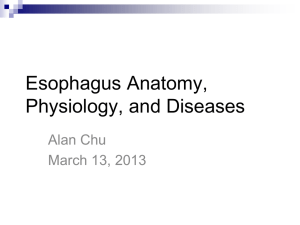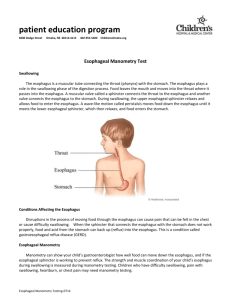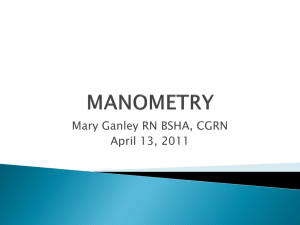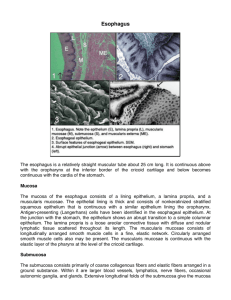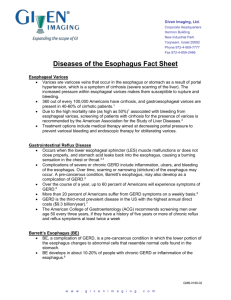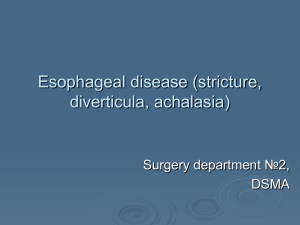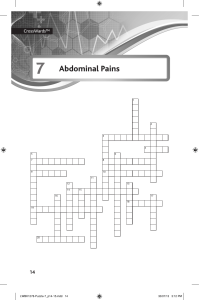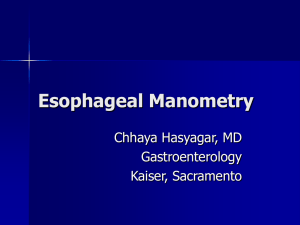Lecture no_ 13_Esophageal Motility Disorders
advertisement
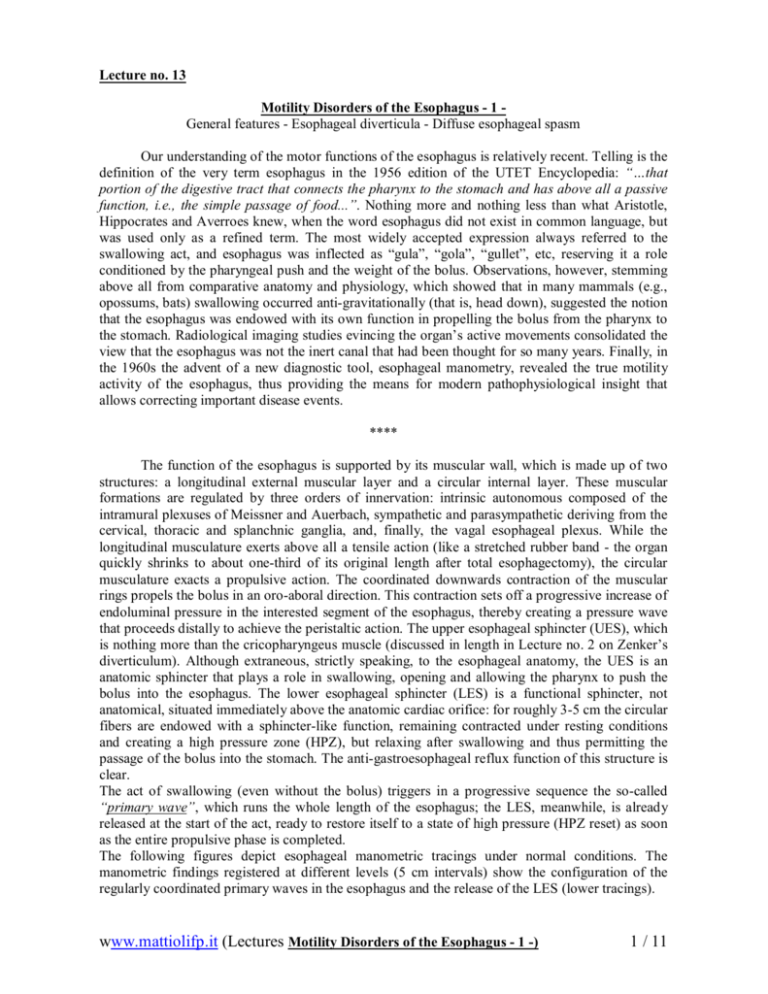
Lecture no. 13 Motility Disorders of the Esophagus - 1 General features - Esophageal diverticula - Diffuse esophageal spasm Our understanding of the motor functions of the esophagus is relatively recent. Telling is the definition of the very term esophagus in the 1956 edition of the UTET Encyclopedia: “…that portion of the digestive tract that connects the pharynx to the stomach and has above all a passive function, i.e., the simple passage of food...”. Nothing more and nothing less than what Aristotle, Hippocrates and Averroes knew, when the word esophagus did not exist in common language, but was used only as a refined term. The most widely accepted expression always referred to the swallowing act, and esophagus was inflected as “gula”, “gola”, “gullet”, etc, reserving it a role conditioned by the pharyngeal push and the weight of the bolus. Observations, however, stemming above all from comparative anatomy and physiology, which showed that in many mammals (e.g., opossums, bats) swallowing occurred anti-gravitationally (that is, head down), suggested the notion that the esophagus was endowed with its own function in propelling the bolus from the pharynx to the stomach. Radiological imaging studies evincing the organ’s active movements consolidated the view that the esophagus was not the inert canal that had been thought for so many years. Finally, in the 1960s the advent of a new diagnostic tool, esophageal manometry, revealed the true motility activity of the esophagus, thus providing the means for modern pathophysiological insight that allows correcting important disease events. **** The function of the esophagus is supported by its muscular wall, which is made up of two structures: a longitudinal external muscular layer and a circular internal layer. These muscular formations are regulated by three orders of innervation: intrinsic autonomous composed of the intramural plexuses of Meissner and Auerbach, sympathetic and parasympathetic deriving from the cervical, thoracic and splanchnic ganglia, and, finally, the vagal esophageal plexus. While the longitudinal musculature exerts above all a tensile action (like a stretched rubber band - the organ quickly shrinks to about one-third of its original length after total esophagectomy), the circular musculature exacts a propulsive action. The coordinated downwards contraction of the muscular rings propels the bolus in an oro-aboral direction. This contraction sets off a progressive increase of endoluminal pressure in the interested segment of the esophagus, thereby creating a pressure wave that proceeds distally to achieve the peristaltic action. The upper esophageal sphincter (UES), which is nothing more than the cricopharyngeus muscle (discussed in length in Lecture no. 2 on Zenker’s diverticulum). Although extraneous, strictly speaking, to the esophageal anatomy, the UES is an anatomic sphincter that plays a role in swallowing, opening and allowing the pharynx to push the bolus into the esophagus. The lower esophageal sphincter (LES) is a functional sphincter, not anatomical, situated immediately above the anatomic cardiac orifice: for roughly 3-5 cm the circular fibers are endowed with a sphincter-like function, remaining contracted under resting conditions and creating a high pressure zone (HPZ), but relaxing after swallowing and thus permitting the passage of the bolus into the stomach. The anti-gastroesophageal reflux function of this structure is clear. The act of swallowing (even without the bolus) triggers in a progressive sequence the so-called “primary wave”, which runs the whole length of the esophagus; the LES, meanwhile, is already released at the start of the act, ready to restore itself to a state of high pressure (HPZ reset) as soon as the entire propulsive phase is completed. The following figures depict esophageal manometric tracings under normal conditions. The manometric findings registered at different levels (5 cm intervals) show the configuration of the regularly coordinated primary waves in the esophagus and the release of the LES (lower tracings). www.mattiolifp.it (Lectures Motility Disorders of the Esophagus - 1 -) 1 / 11 Fig. 1 - Normal esophageal motility The two manometric tracings above show the normally coordinated primary waves that ensure an effective propulsive action. The third tracing reveals a higher basic pressure compared to the above (HPZ-LES). The compressive deflection following the LES release is evident immediately before the arrival of the primary wave. Fig 2. - Normal manometric tracing as in Fig. 1. www.mattiolifp.it (Lectures Motility Disorders of the Esophagus - 1 -) 2 / 11 Fig. 3 - Normal digital manometric tracing. fig. 4 fig. 5 Normal LES (HPZ) digital 3D reconstruction Fig. 4 - at basic resting conditions Fig. 5 - residual pressure after release Over a 24-hour period episodes of gastroesophageal reflux occur that are reputedly normal, since they do not harm the esophageal wall (note should be made of the difference with gastroesophageal reflux disease [GERD]). The harmlessness of these entirely transient reflux episodes is conditioned by the activity known as cleaning & clearing, an autonomous mechanism that quickly clears the esophagus. Beginning at the medial-inferior third of the organ, propulsive movements known as “secondary waves” are generated, which expel the reflux. Whereas the primary wave is triggered by a voluntary action, i.e., swallowing, the secondary wave is completely controlled by local stimuli. In the paragraphs devoted to disease pictures we will see abnormal motility phenomena, at times segmental and simulating even the configuration of functional sphincters. At this point, the adage www.mattiolifp.it (Lectures Motility Disorders of the Esophagus - 1 -) 3 / 11 that “the esophagus can create a sphincter wherever it wants” is suggestive. This pathologic activity is characterized by the so-called “third waves”. **** The primary alteration of esophageal motility harmony leads to pathologic conditions, which are at first functional, but become organic (as a consequence of the first). Different disease pictures are well-known: - esophageal diverticula - diffuse esophageal spasm - esophageal achalasia - GERD **** Esophageal diverticula In Lecture no. 2 of this website we discussed Zenker’s pharyngoesophageal diverticulum, which many works continue to include among esophageal diverticula. This disorder, however, is an example of the organic consequence of a motility disorder, that is, the lack of coordination between the pharynx and the UES. Those known as pulsion diverticula, which are to be distinguished from the traction variety, are the subject of this Lecture. These may be detected at any level of the esophagus. Those of the lower third are called epiphrenic. Made up of esophageal mucosa pushed outwards by a breach of the muscular wall, these formations correspond to Rokitansky’s mucosal hernia and are due to increased endoesophageal pressure stemming from uncoordinated motility above and reception below (downstream dyschalasic segment). For epiphrenic diverticula of the lower third, dischalasia stems from the poor functioning of the LES. These can at times complicate an achalasic megaesophagus. For diverticula of the most proximal levels, the dyschalasic segment is caused by an anarchic tertiary wave, which often has the features of a functional sphincter. The symptoms are governed by the diverticulum’s dimensions. Episodes of regurgitation with an intensity proportional to the diverticulum’s volume may be associated with intermittent dysphagia. Instrumental diagnosis is based on barium radiography (barium swallow), endoscopy, and esophageal manometry. The first two examinations detect morphological features, while the third reveals pathogenetic characteristics. Therapy is surgical and is performed only when the intensity of disturbances becomes significant. Surgery entails removal of the diverticulum and extramucosal longitudinal myotomy (interruption of the circular muscular fibers) of the downstream dyschalasic segment (LES or functional pseudo-sphincter). The procedure may be performed by thoracotomy or by video-thoracoscopy (see video); at times, for epiphrenic diverticula, a laparotomic approach or video-laparoscopic via a transhiatal route may be attempted. www.mattiolifp.it (Lectures Motility Disorders of the Esophagus - 1 -) 4 / 11 Fig. 6 - Midesophageal diverticulum. Note the air-fluid level. a b Fig. 7 - More radiographic images of midesophageal diverticula www.mattiolifp.it (Lectures Motility Disorders of the Esophagus - 1 -) 5 / 11 Fig. 8 - Image of an epiphrenic esophageal diverticulum with air-fluid levels a b c Fig. 9 - Large epiphrenic diverticula. a) completely filled diverticulum b) with air-fluid levels c) epiphrenic diverticulum after emptying: note the compression on the esophagus www.mattiolifp.it (Lectures Motility Disorders of the Esophagus - 1 -) 6 / 11 Fig. 10 - Epiphrenic diverticulum in achalasic megaesophagus Fig. 11 - Midesophageal diverticulum: the arrow indicates the manometric (HPZ) tracing of the sub-diverticular segment. Note the pseudo-sphincter features of the HPZ. www.mattiolifp.it (Lectures Motility Disorders of the Esophagus - 1 -) 7 / 11 a b Fig. 12 - Esophageal manometry in midesophageal diverticula. a) The violet tracing corresponds to the sub-diverticular segment and expresses an HPZ simulating sphincter function. b) Another case of midesophageal diverticulum: the green tracing corresponds to the subdiverticular HPZ. Note the sphincter-like function with related releases. www.mattiolifp.it (Lectures Motility Disorders of the Esophagus - 1 -) 8 / 11 Diffuse esophageal spasm Diffuse esophageal spasm is characterized by a disruption of normal esophageal motor function. These range from primary forms (the subject of what follows below) to a variant that is generally secondary to GERD, with which it will be discussed in a forthcoming lecture. A brief presentation of the radiological picture and of the esophageal manometric features of diffuse esophageal spasm provides some helpful insight before discussing the disorder’s clinical picture. a b Fig. 13 - diffuse esophageal spasm a) esophageal X-ray = corkscrew esophagus, rosary bead esophagus, nutcracker esophagus, etc. b) compared to normal manometry tracing, note the motor disorder on the left and the high pressure tertiary waves www.mattiolifp.it (Lectures Motility Disorders of the Esophagus - 1 -) 9 / 11 a b Fig. 14 - diffuse esophageal spasm - manometry tracing revealing a significant motility disorder. Note the tertiary waves that reach extremely high pressures (nutcracker esophagus) with full scale amplitude values. www.mattiolifp.it (Lectures Motility Disorders of the Esophagus - 1 -) 10 / 11 Symptoms are characterized by pain - retrosternal, violent, increasing, reflecting a picture of angina-like pain - all the more because it is constrictive, and radiates to the jaw, the upper limbs and the interscapular region. In fact, these complaints are often misinterpreted as having a cardiologic etiology. Episodes of painful dysphagia (odynophagia) are not uncommon. These crises often repeat with moderate frequency, provoking serious discomfort and states of anxiety and/or depression. At times, stressful events or drinking cold beverages may precipitate these painful crises. Often the patient will attribute the onset of pain to particular foods; as a result, a decline in nutritional status may be seen. Patients may present with concomitant functional disturbances of other regions, particularly the gastrointestinal tract (irritable bowel syndrome, spastic colon). Other possible triggering diseases (e.g., gallstone, peptic ulcer disease, etc.) have been described. At onset, diagnosis may often be mistaken with a coronary event, but a demonstrated lack of cardiac involvement and, as we have seen above, the undeniable radiological and manometric evidence definitively rule out a cardiovascular etiology. At the same time, these latter investigations may be entirely negative if measurements are made in patients under conditions of quiescent esophageal motility; findings become clearly positive if the examinations are carried out during a painful episode. If symptoms of GERD (epigastric and retrosternal pyrhosis, etc.) are also present, a differential diagnosis to elucidate the secondary form becomes necessary, and as such require esophago-gastroscopy and esophago-gastric pH monitoring. Moreover, in some cases the finding of concomitant hypertonic LES waves may lead to a suspected vigorous achalasia (which, in any case, will be discussed in an upcoming lecture). Therapy for the primary form is anything but simple. Medical treatment (calcium channel blockers, nitrates, antispastic drugs) usually has only a transient effect. Long extramucosal myotomy of the esophagus, which entails the longitudinal sectioning of the circular musculature, is a reliable solution: in essence, the procedure interrupts the continuity of the muscular rings, thereby weakening the amplitude of their contractions. Sectioning is performed above (without involving) the LES, up to the crossing of the esophagus with the aortic arch. Outcome is measured by the degree to which the mucosa herniates along the entire length of the myotomy. This operation may be performed by left thoracotomy, but video-thoracoscopic approach is preferable. ----------------- www.mattiolifp.it (Lectures Motility Disorders of the Esophagus - 1 -) 11 / 11
